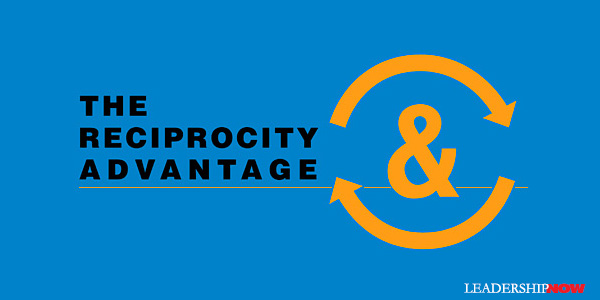 |
 |
04.24.17

The Reciprocity Advantage
G In The Reciprocity Advantage, authors Bob Johansen and Karl Ronn state that the next competitive advantage will be reciprocity advantage. Reciprocity and advantage will spark new business models for innovation and growth. Most business is transactional but “reciprocity is the practice of exchanging with others for mutual benefit. In a reciprocity-based model, I give you something, and at some later point in time, I trust that I will learn how to get even more value back in return.” It’s what the authors call “smart giving.” “The reason for giving assets away isn’t just about doing good—it’s an important part of an ongoing value exchange spread over time where partners commit to looking out for each other as part of a shared vision.” While the principles they lay out apply both organizationally and individually, they note that reciprocity advantage must be done on a large scale to make a significant difference. “A reciprocity advantage is a chance to do good while also doing very well. A reciprocity advantage is delicate to achieve and maintain. Go too wide, and you’re a philanthropist. Go too narrow, and you’ll be back doing transactions.”
You begin by defining your core business. This is where you will find the right-of-way assets you can share. Not all should be shared. You must do this inventory and then decide later what to keep and what to share. Then reinvent your business as a service. The rights-of-way that your core needs to survive disruption are not to be shared. This would hurt your business. Instead, invest to prevent long-term obsolescence. Finally, redefine your business as an experience. Having attained clarity on what you do as a service, focus on the users of your service. What are you being hired to do? By looking for services that people want but don’t yet have, you will find new ways to complement your core business. The rights-of-way that enable this are the core of the new reciprocity business. 2. Find the Best Partners
3. Learn by Experimenting
4. Scale It
So, how will you know if your idea is desirable, viable and ownable? The authors have created a scorecard to direct your development efforts. Each of the three areas is divided into two opposing measures: Is it desirable? To scale it must be transformational and intuitive. Is it viable? To be viable it must be affordable and structurally attractive. Is it ownable? It needs to be feasible at your intended scale and have a source of sustainable competitive advantage. The breakthrough occurs when you resolve the three pairs of opposing forces. When you have all six parts working for you, run! Your idea is now no longer risky. Until then use keep experimenting cheaply. The authors conclude, “We believe that givers will be much better at creating reciprocity advantage for their companies and for themselves.” 
Posted by Michael McKinney at 10:22 PM
|
BUILD YOUR KNOWLEDGE
 

How to Do Your Start-Up Right STRAIGHT TALK FOR START-UPS 
Grow Your Leadership Skills NEW AND UPCOMING LEADERSHIP BOOKS 
Leadership Minute BITE-SIZE CONCEPTS YOU CAN CHEW ON 
Classic Leadership Books BOOKS TO READ BEFORE YOU LEAD |